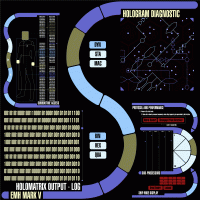EMH Mark V
From FEInfobase
Kayvin Jal (Talk | contribs) m |
m |
||
| Line 3: | Line 3: | ||
== Program Deployment == | == Program Deployment == | ||
| − | Upon most refits and constructions of newer vessels, EMH Mark V's have been installed. Classes like the [[ | + | Upon most refits and constructions of newer vessels, EMH Mark V's have been installed. Classes like the [[Century class]] and [[Diligent Class]] come with the EMH Mark V pre-installed. |
== Features == | == Features == | ||
Latest revision as of 05:40, 5 March 2010
The EMH Mark V is the most recent hologram developed by Lewis Zimmerman for standard starship deployment. The program was completed in 2403, and Starfleet finished their modifications and approved it for deployment in early 2405.
Contents |
Program Deployment
Upon most refits and constructions of newer vessels, EMH Mark V's have been installed. Classes like the Century class and Diligent Class come with the EMH Mark V pre-installed.
Features
Direct Interface
Previous EMH models were completely seperate from the ship's computer, to more closely emulate human behavior. However, efficiency in emergency situations has promoted the process of linking the EMH program directly with the ship's computer, on a limited basis. The EMH's ability to read computer data is identical to a computer console, where an access code is required to access various parts of the ship's systems. The EMH's access code allows it to access medical records and the library computer. Access to any ship functions and command structures is strictly prohibited.
Program processing capability does not permit the program to access the computer and function physically at the same time, so the program will cease motion for a short time while downloading data from the computer. During the time, it has been noted that the eyes of the hologram lose their human appearance. Whether this is a programming glitch, or an intentional notifier of digital activity designed by Zimmerman, Starfleet is unsure.
Instant Emitter Transference
The EMH Mark V is capable of automatically transferring itself to another set of holo-emitters. This ability, nicknamed "shimmering" after the visual distortion that the hologram's physical parameters experience during the process of generating and terminating a physical hologram, allows a hologram to seemingly teleport itself to other parts of the ship equipped with holo-emitters instantly.
Unfortunately, this function has limited use because of the lack of ability to move medical equipment at the same time. Starfleet has looked into the possibility of site-to-site beaming equipment to coincide with a shimmer, but it was determined that this would be inefficient and a poor use of ship resources.
Long-Term Operation
The EMH Mark V was designed for use for either emergency or long-term use. Settings in the program's code allow it to be preset for long-term use before initial loading, though the default design is set for emergency use.
Core Programming Directives
The First Directive
An EMH's first directive is always the medical care and well-being of organic life forms. On medical grounds, an EMH will do whatever is necessary to preserve life.
The Second Directive
The "Second Directive" was a function added to the EMH's programming by Starfleet after Zimmerman finished his design for the program. It was added to address Starfleet's concerns about holograms who continually acted "over-independent". The second directive ensures that as long as it does not violate the first directive, the EMH Mark V must follow all orders given to it by any member of the crew of the starship it is assigned to. The program is not compelled to follow the orders of Starfleet personnel from other vessels.

